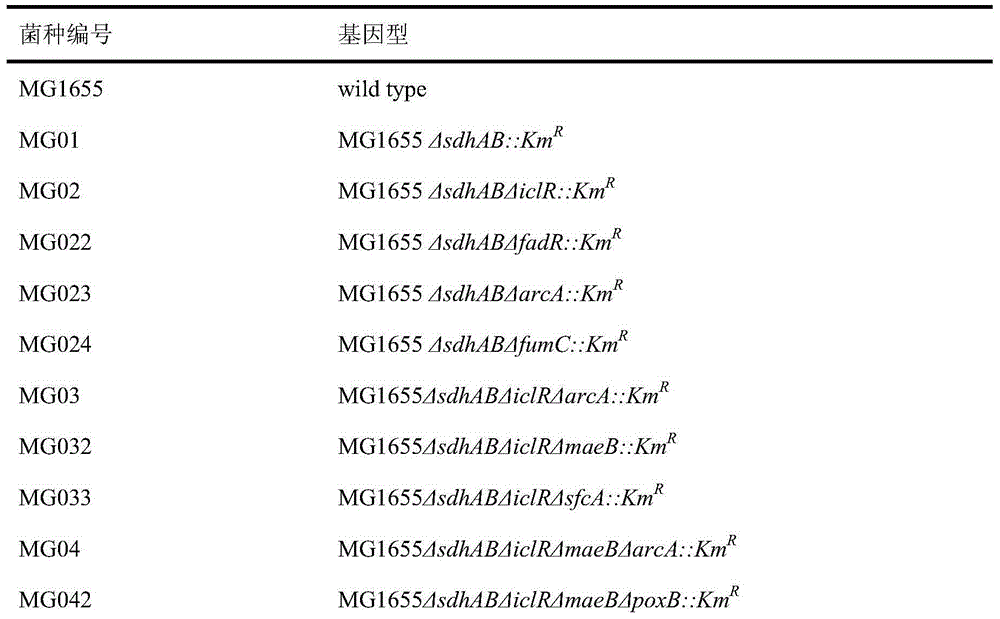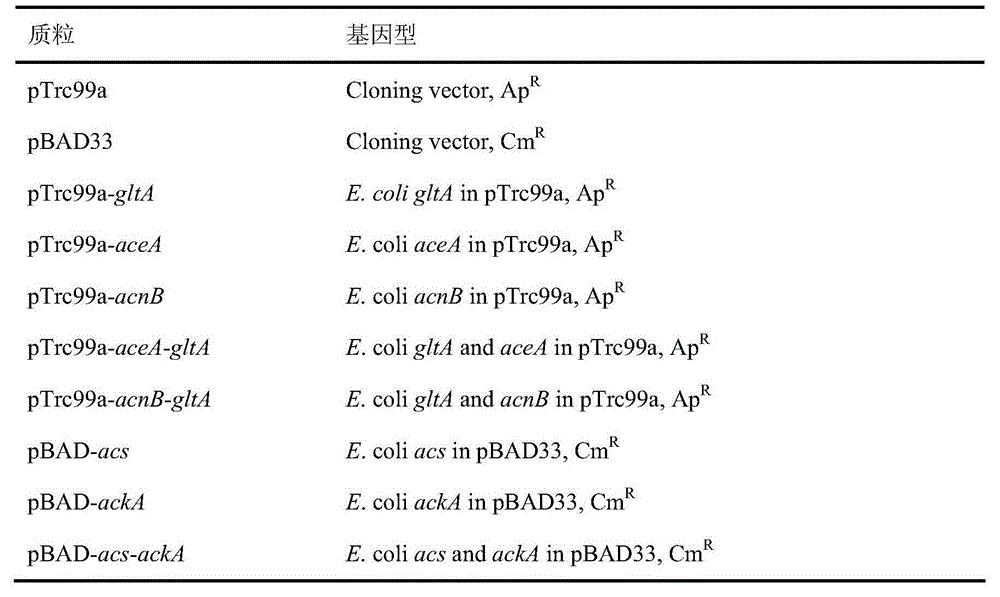Construction method and applications of metabolic engineering escherichia coli strain for producing succinic acid by using acetic acid
A technology of Escherichia coli, metabolic engineering, applied in the field of bioengineering
- Summary
- Abstract
- Description
- Claims
- Application Information
AI Technical Summary
Problems solved by technology
Method used
Image
Examples
Embodiment 1
[0042] Example 1. Knockout of genes to obtain succinic acid producing strains
[0043] The genes sdhAB, iclR, arcA, ldhA, sfcA, maeB, sucABCD, poxB, adhE, fumC, fadR were knocked out by red recombination technology. The specific operation is as follows:
[0044] For the knockout of the gene sdhAB, first use the sequence of primer 1 (F-sdhAB) of SEQIDNO:1 and the sequence of primer 2 (R-sdhAB) of SEQIDNO:2, and use pKD4 as a template to PCR clone a DNA fragment of about 1700bp. The plasmid pKD46 was introduced into the host bacteria through calcium transformation, and recombinants were screened with ampicillin. Recombinant bacteria introduced with pKD46 were cultured at 30°C to OD 600 At about 0.3, L-arabinose was added for induction for 1 hour, and then 10% glycerol was used to prepare electroporation competence. Electroporation was performed using bacterial mode 1 (1.8KV, 5ms). Transformants were selected for homologous recombination using kanamycin. Then use sequence as...
Embodiment 2
[0049] Example 2. Overexpression of glyoxylate cycle key enzyme genes gltA, aceA and acnB.
[0050] The citrate synthase gene gltA derived from Escherichia coli was overexpressed using the plasmid pTrc99a. First use sequence is the primer 35 (pTrc99a-gltA-F (BamH1)) of SEQIDNO:29 and the sequence is the primer 36 (pTrc99a-gltA-R-Hind3) of SEQIDNO:30, with Escherichia coli MG1655 as template PCR clone has enzyme The gltA gene at the cleavage site. Then use BamHI and HindIII to double-enzyme digest pTrc99a and the target fragment recovered by PCR. After recovering the digested product, use T4 ligase to ligate at 16°C. Calcium is then converted into the strain of interest. Use ampicillin resistance to select successfully constructed recombinant bacteria. Protein electrophoresis to determine whether the protein is expressed. Extract the plasmid from the strain with correct expression, send it for sequencing, and record it as pTrc99a-gltA.
[0051] Plasmid pTrc99a was also use...
Embodiment 3
[0063] Embodiment 3. produce succinic acid strain compound medium shake flask fermentation
[0064] Using Escherichia coli MG1655 as the starting strain, the gene sdhAB was knocked out, the TCA cycle was blocked, and the succinic acid-producing basic strain MG01 was obtained.
[0065] On the basis of the single deletion strain MG01, the genes iclR, fadR, arcA and fumC were knocked out respectively to obtain strains MG02, MG022, MG023 and MG024. After comparison, it was found that MG02 had the best effect, so MG02 was used as the starting strain next.
[0066] On the basis of the double-deletion strain MG02, the effects of blocking the supply pathway and activating the TCA cycle on the fermentation of succinic acid were verified, so the genes arcA, maeB, and sfcA were knocked out to obtain strains MG03, MG032, and MG033. The fermentation results showed that MG032 had the best effect, so the follow-up transformation was carried out based on MG032.
[0067] In order to understa...
PUM
 Login to View More
Login to View More Abstract
Description
Claims
Application Information
 Login to View More
Login to View More - R&D
- Intellectual Property
- Life Sciences
- Materials
- Tech Scout
- Unparalleled Data Quality
- Higher Quality Content
- 60% Fewer Hallucinations
Browse by: Latest US Patents, China's latest patents, Technical Efficacy Thesaurus, Application Domain, Technology Topic, Popular Technical Reports.
© 2025 PatSnap. All rights reserved.Legal|Privacy policy|Modern Slavery Act Transparency Statement|Sitemap|About US| Contact US: help@patsnap.com



